|
| |
Back to Private
Aircraft
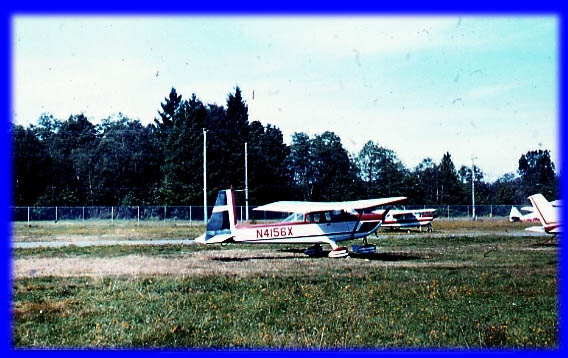 |
The Aero Commander company bought the
Volaircraft design in 1960, and produced it as the Aero Commander 100.
It was produced in two versions: the 150hp Darter Commander and the
180hp Lark Commander. Later versions had a swept fin, making them
visually hard to tell apart from Cessna 172s, with which they were
competing. They are quite similar designs. This is a four seater, 22
feet 6 inches long and with a wing span of 35 feet, and gross weight
of 2,250lb. Top speed is 125mph. It was only moderately succesful,
with 341 Darters and 213 Larks having been built by the time
production ended in 1970.
This is a very degraded picture of a Darter
Commander at Abbotsford in September 1981. |

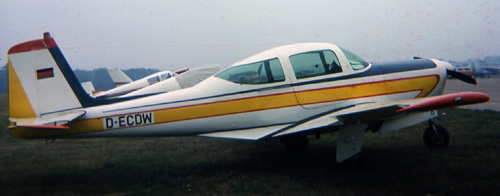 |
The Aero Commander 200 ranks alongside the
Ryan Navion and Piaggio 149 as one of the best high performance four
seat tourers of the post-war period. It derives from the 1953 Meyers
200, 46 of which were built before the design rights for which were
bought by Aero Commander. It is powered by a 260hp Continental
IO-470, though some versions had the 285hp IO-520. Construction
standards are first class, and it is a highly sought-after machine.
It cruises at 215mph and has a range of 1,100 miles. It is 24 feet 5
inches long, with a wing span of 30 feet 6 inches and gross weight
of 3,000lb. Sadly, only 77 were built by aero commander before it
was discontinued as they felt the cost of construction to be
excessive. Their response to this was to develop the Commander 112,
a very good machine (I've got one!) but scarcely in the same league
as the 200.
Top: Cranfield, date uncertain
Lower: Biggin Hill, August 1975. |
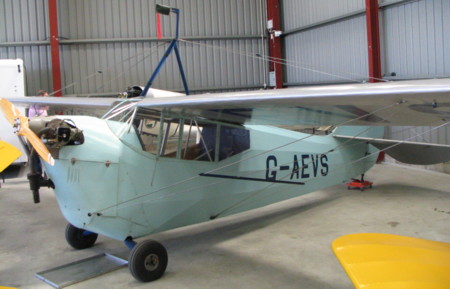 |
Not for nothing was this bizarre aeroplane
known as the `flying bathtub'! Designed by the Aeronautical Company
of America (AERONCA), the C3 was a tiny (20 foot long, 36 foot span)
light (450Kg gross weight) and underpowered (36hp Aeronca engine)
single seat aircraft dating from the early 1930s. Note the bracing
post and wires providing stiffness to the wing.
This rare example is preserved at the Real
Aeroplane Museum, Breighton |
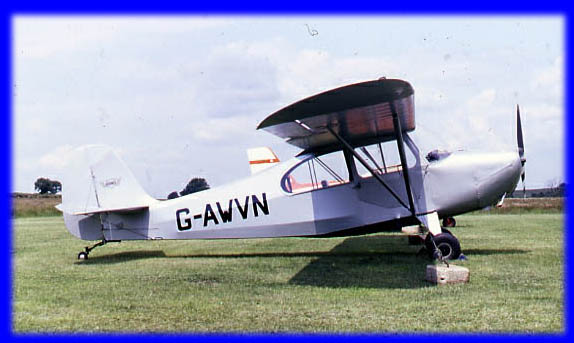 |
The Aeronca 7AC Champion was the first
post-war aircraft built by the American Aeronca corporation, famous
previously as the producer of simple, reliable, low cost and
low-powered light aeroplances such as the C-3. The 7AC is powered by
a 65hp Continental engine, and has a surprisingly spacious enclosed
cabin for two seats in tandem. Cruising speed is a sedate 90mph, and
gross weight 1,220lb. It is a compact aircraft, 21 feet 6 inches
long, with a wing span of 35 feet. The US Army used it as a light
liaison aircraft, designated L-16. It first flew in 1945. Over
10,000 were built between then and 1951. This
one was at Rush Green in June 1980. |
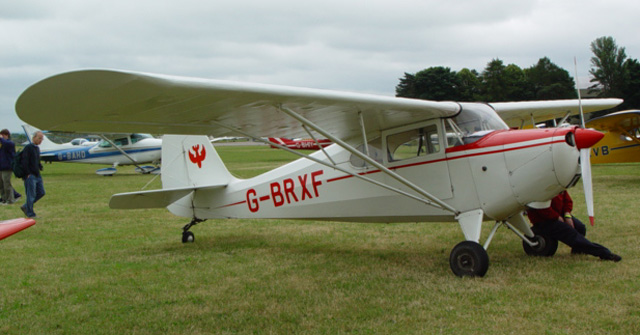 |
The Aeronca 11AC Chief is essentially the
same airframe as the 7AC, but fitted with a new cabin for two seats
side by side, and featuring control yokes rather than sticks. Engine
is the same, but the cruising speed manages to be a bit faster
(100mph) despite the wider cabin. Range is 315 miles. 2,325 were
built, plus 154 built under license in India as the HAL Pushpak,
with a more powerful 90hp engine. It is slightly heavier (1,350lb
maximum weight) and shorter (20 feet 10 inches) and with a slightly
wider span (36 feet, one inch) than the 7AC.
Photograph by Ivy at Kemble, July 2005. |
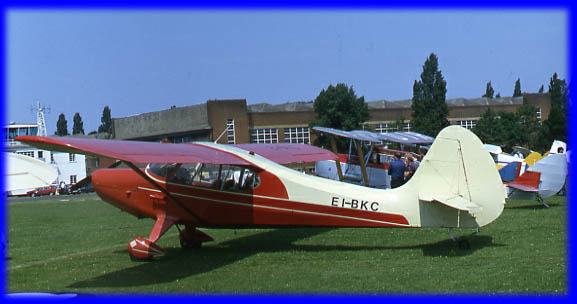 |
The Aeronca 15AC Sedan is a four seat touring
development of the 7AC/11AC line. Powered by a 145hp COntinental
engine, it cruises at 115mph and has a maximum gross weight of
2,050lb. At 25 feet 3 inches long and with a wing span of 37 feet 6
inches, it is only slightly bigger than its two seat forebears.
First flown in 1947, 561 were made before Aeronca ceased operations
in the early 1950s. This Irish registered example was at Cranfield
in July 1983. |

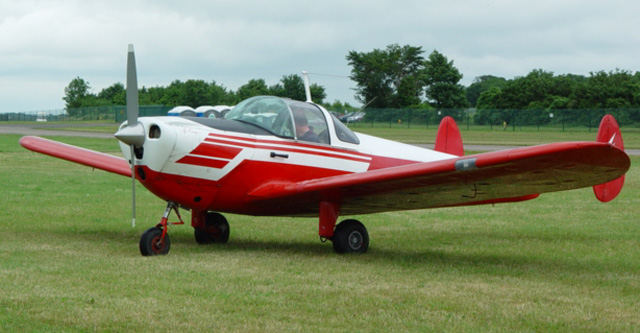 |
The Alon Aircoupe, together with the Forney
F-1A, represent continued post-war production of the 1937 Ercoupe
415. It was originally designed by Ed Weick, who later cooperated
with Al Mooney to develop the Piper Comanche. This was a little two seat touring aircraft of quite advanced
design for its day, and is instantly recognisable by its twin oval
tails. Initial versions had no rudder pedals, the rudder being
interlinked with the ailerons. They were meant to be impossible to
stall (but do sink very fast if you get too slow!) They had a variety of Continental engines, ranging in power
from 65 to 90hp. All versions have the same basic dimensions: length
of 20 feet 2 inches and wing span of 30 feet, with a noticeably
thick wing section and high dihedral. It will cruise at 110mph for a
quite respectable range of 500 miles. Over 5,500 were built, of all
versions by all makers, including a handful by Mooney after they
took over Alon in the 1960s. One was evaluated during the war as the
YO-55, but was not pursued for military purposes.
These very similar pictures were taken at very dissimilar times: the
top one at Cranfield in July 1980, and the lower one by Ivy at
Kemble in July 2005. |
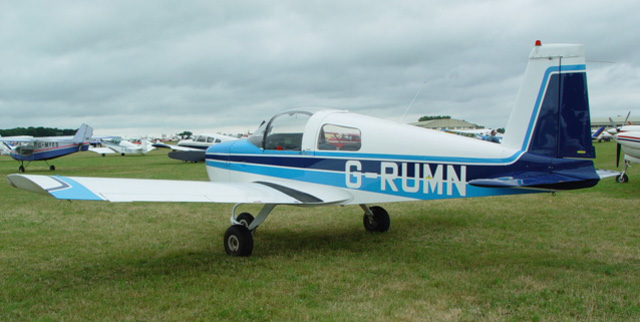 |
The American Aviation AA1 Yankee was designed
by Jim Bede as a low-cost light two seat private aeroplane. It first
flew in 1963 and has been moderately popular, with good operating
economics outweighing the slightly cheap feel of the construction
(which, in fairness, was the whole point really). Powered by a 108hp Lycoming engine, it cruises at a nippy 135mph over a range of 450
miles. At 19 feet 3 inches long and with a wing span of 24 feet 5
inches, it is also quite a small aeroplane: definitely not for the
obese. American Aviation was taken over by Grumman, who rebranded
the aircraft as the Trainer. About 1,770 were built.
This one was at Kemble in July 2005. Photograph by Ivy |
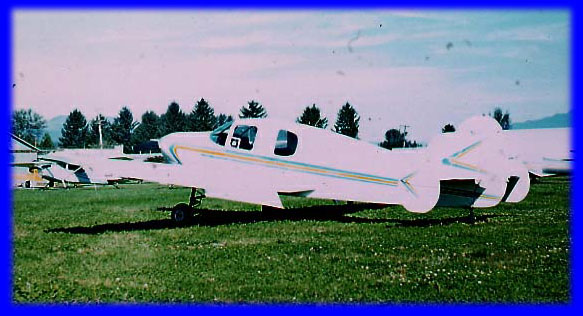 |
This heavily deteriorated picture is the only
one I have of a Bellanca Cruisair. A sleek four seater of rather
antique appearance, it was in fact a 1945 update of a pre-war design
by Giuseppi Bellanca. It was originally fitted with a 150hp Franklin
engine, which gave a cruising speed of 150mph (one mph per hp was a
particualr selling point). This is at the expense of a slightly
narrow cabin. Later updates, including the Cruisemaster and Downer
260, had more powerful engines, up to
260hp engine which gave it a very good cruising speed of 185mph. It
is largely made of wood, which gives great strength and lightness
but means they shouldn't be kept outside, especially in extremes of
heat, cold or humidity: this accounts for there being fewer about
than their metal contemporaries. Empty weight is only 1,240lb, and maximum weight is 2,700lb.
Length is 22 feet 11 inches and wing span 34 feet 2 inches. A
particularly odd feature is the undercarriage, which is retracted by
the pilot winding a crank handle! Simple and effective, but tiring.
The triple tail is very distinctive. This one was at Chilliwack in Canada in
September 1981. |
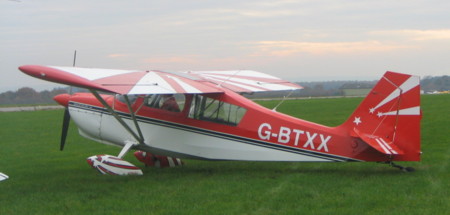 |
The Bellanca Decthalon is a re-working of the
Champion Citabria (see below) for the aerobatic training market. The
lineage is impressive, the original airframe concepts dating back to
the 1930s Aeroncas, and it is very strong.
This 8KCAB Dethalon was built in 1980, and is
powered by a fuel-injected Lycoming AEIO-320 engine. It was at
Tatenhill in November 2007. |
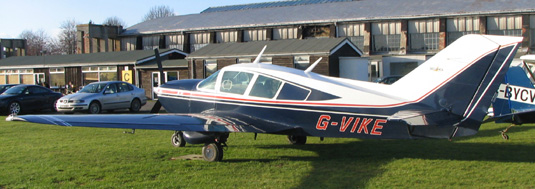 |
The Bellanca Viking is simply an update of
the Cruisair, with nosewheel undercarriage, a more powerful 300hp
Continental engine, and a single swept tail. Like the Cruisair it is
a four seater, built of metal tube covered in fabric, and the same
lovely smooth wing whose surface is plywood covered with fabric -
very low drag! It cruises at up to 200mph, and has a 4 to 5 hour
endurance. Gross weight is a useful 3,325lb. Over 1,500 were built
from 1967; it is still available to order. It is a bit longer than
the Cruisair, at 21 feet 3 inches. This
smart Viking was at Old Sarum in February 2006. |
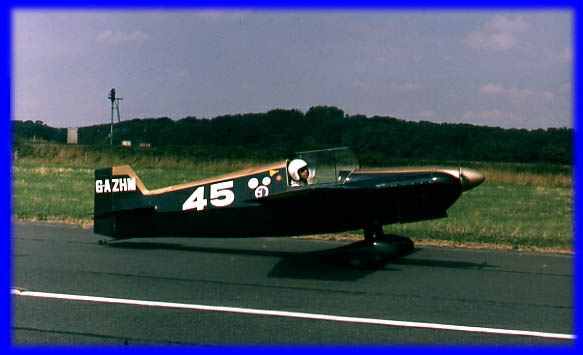 |
The Cassutt Racer was designed by American
designer Tom Cassutt, and first flew in 1954. It is designed
specifically for `Formula One' air racing, so conforms to the
standards. It is a single seater, very small (16 feet long and with
a highly loaded wing of only 15 feet span), light (maximum weight is
820lb) and fast (top speed is 195 mph on a mere 90hp). Many have
been home-built by amateur builders.
This one was competing in a race at Teesside in the 1970s, exact
date unknown. |
|
|
The Champion 7KCAB Citabria is descended
directly from the Aeronca series, via the Champion company who
bought the rights after Aeronca ceased trading. The design was
strengthened and updated, equipped with a much more powerful engine
(150hp Lycoming IO-320), and was marketed as the Citabria - which is
`Airbatic' spelt backwards. It retains the primarily fabric
construction of the earlier design, over a steel tube framework,
which gives a good combination of lightness (maximum weight is only
1,650lb) and strength. It also retains the two seat tandem seating
arrangement. It has a full inverted fuel and oil system. Wing span
is 33 feet 5 inches; length, 22 feet 8 inches; top speed is 125mph
and range 565 miles. These pictures were
taken by David's father at Headcorn in July 1977, with a teenage
David in the back seat about to be taken into the air by his
father's cousin Harry. This included David's first introduction to a
manoeuvre called a `rolling circle' - the aircraft flown in a circle
over the ground, but rolling about its axis the whole way round.
This was a dimension he never knew existed before!
|
 |
The Champion 7FC Tri-Traveller is essentially
a nosewheel version of the Aeronca 7AC. Powered by a slightly more
powerful Continental C-90 engine, it first flew in 1957. It is a
tandem two seater, which cruises at 110mph and has a range of 500
miles. It is 21 feet 8 inches long, with wing span of 33 feet 5
inches, and gross weight of 1,450lb
Cranfield, July 1988 |
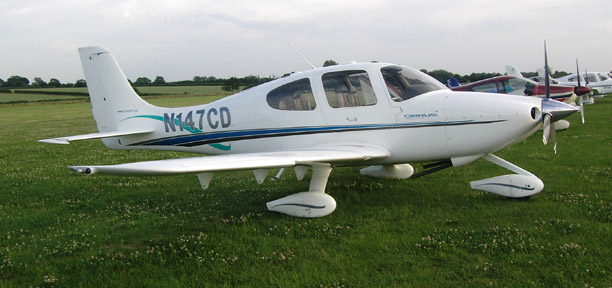 |
The Cirrus SR20 is one of a new breed of
composite light aircraft developed in the 1990s. It includes
advanced avionics and numerous safety features, including a unique
parachute recovery system. The SR20 is powered by a 200hp
Continental IO-360 flat six engine, giving it a top speed of 175mph
and range of 880 miles. Seating four, its gross weight is 3,000lb.
It is 26 feet 3 inches long, with a wing span of 35 feet 7 inches.
The SR22 is similar, but powered by a 310hp engine which makes it
heavier and faster and go further.
Cirrus now claim to be the world's second largest producer of light
single engined aircraft. The SR range is still in production as of
October 2005, with over 1,000 having been made since its
introduction in March 1995. |





|